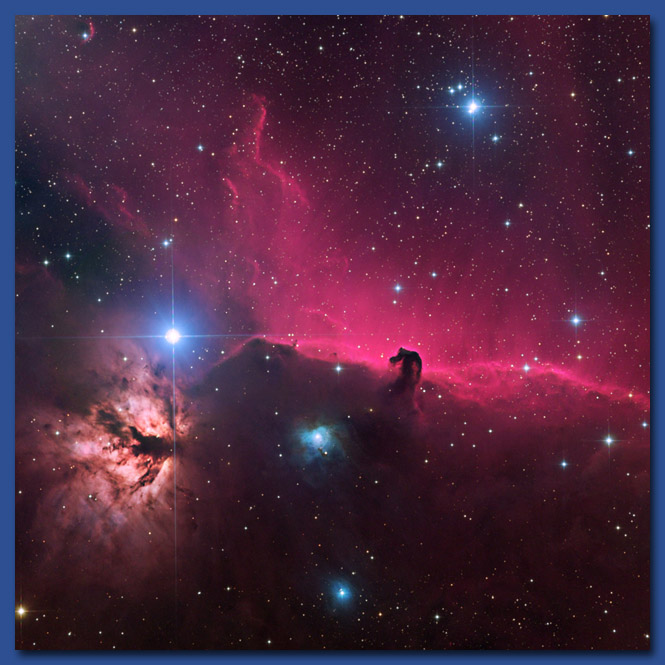Technical > Astronomical Photography > Deep sky imaging
Not for the faint of heart
Photographing the night sky is probably the most demanding and difficult of all photography. One cannot truly appreciate the time and skills involved to produce a good deep sky image without actually doing it.
The image below shows Peter's setup of his own designed and built 300mm corrected Cassegrain astrograph. The blue camera on the back is an Apogee U16M 4000K pixel CCD camera. All of the deep sky images in this website were taken with this setup.

It all looks impressive and some may think that all you have to do is spend money and start snapping away, but getting the images takes zen like patience and understanding.
This image of the famous Horsehead nebula is actually a combination of hundreds of images taken with 6 different filters. This object in the sky is so faint that you cannot see it with your own eyes. Even seeing it through a telescope is difficult. So, many hours of accumulated data for each separate filter must be taken to get above the noise level.

It's one thing to successfully and accurately aquire enough quality data of an object but then the hundreds of images have to be calibrated, combined, registered, colorized and carefully processed. One could spend years on perfecting the techniques. There are many books written, workshops and imaging conferences to go to and software created to help one climb the learning curve of processing deep sky images.
Aquiring the images
Because the Earth is in constant motion, capturing sharp photos of tiny celestial objects in the night sky is a huge challenge. So the telescope mount must not only track the stars but do so extremely accurately. All components of deep sky imaging are important but the mount is probably number one. Without this accuracy, the photos will be ruined and it can happen easily.
This photo of the North American nebula below is the result of many things going wrong with the mount. Strong gusting winds buffeted the mount caused a shaking motion and the rectangular pattern, periodic error from the the gears in the mount's motor caused the squiggle pattern and poor polar alignment caused slipping of the whole image downward.
You can have the best telescope and camera equipment available but if the mount is not strong or working properly or aligned well, it can compromise everything else. When the tracking is properly set up and the telescope, cameras, filters, focuser and any other equipment are all working well together, it's good to get as much data as possible. The more data on any object, the better.
The digital darkroom
Peter does all the aquisition of the images in the field, usually freezing and all night long, while Debra sits comfortably inside in front of the computer managing all the raw data and processing the images.
The image processing usually takes much longer than the image aquisition. One can work on an image for dozens of hours. Then in the future, the same image is often processed again when techniques are improved. Therefore it is important to keep organized files of all original data.
Here is a pdf of Debra's workflow for processing.
Go here to learn about our image processing philosophy.